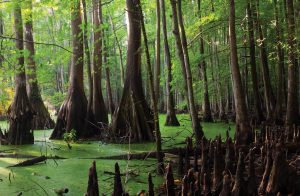
A safe place.
1700, Great Dismal Swamp, covering perhaps 1,600 square miles of Carolina and southeastern Virginia, sought out by runaway slaves, with likely help from Indians. Develops into largest refuge of maroon families in the colonies.
Maroon community survives construction of Dismal Swamp Canal, begun in 1793, and a militia raid in 1823. Mosquitoes, water moccasins and trackless, waterlogged forest keep slave hunters out.
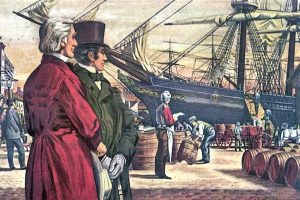
Port of slavers.
1700, Price for male slave in a Slave Coast factory: £3 in goods. Price at auction in West Indies: £20, according to the Royal African Company, no longer holding a monopoly.
Liverpool is a fishing village on the Mersey with 5,000 residents. But its merchants begin to move into slaving. A century later, it is a leading port of 58,000 with Triangular Trade slaving credited for most of its growth and wealth.
Slave ships are built, crewed and loaded in Liverpool with trade goods for the First Passage to Africa. Very rarely are slaves brought to Liverpool.
1701, War of Spanish Succession opens, in which Britain, Portugal and the Netherlands fight to maintain separation of French and Spanish thrones. The death of Charles II (Spain’s last Habsburg king and childless) opens throne to Philip of Anjou, Spain’s first Bourbon king. He is also in the line of succession to France’s throne.
In North America and the Caribbean, it is known as Queen Anne’s War, pitting British colonies against those of France and Spain.
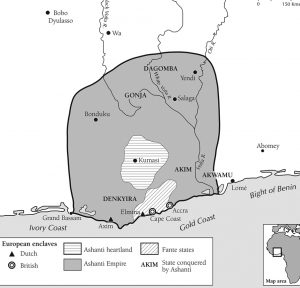
Ashanti reach coast.
1701, Denkyira people, weakened by Komenda Wars, are defeated on Gold Coast by Osei Tutu, who expands the militaristic Ashanti empire to the Atlantic. Gold and slave trade with Europeans brings wealth.
Ashanti maintain their independence through 19th century.
1702, James Moore, Carolina governor, leads raid of colonists and Yamasee Indian allies into Spanish Florida to gather Indian slaves and besiege Castillo de San Marcos at St. Augustine. Spanish warships from Havana force Moore to retreat, burning a number of his boats, December.
In 1704, Moore leads raids with Yamasee and Creek allies against Apalachee Indians and Spanish missions near Apalachee Bay on the Gulf side.
The fighting, part of Queen Anne’s War in the colonies, significantly weakens Spanish in Florida.
1703, More than 40% of New York households hold slaves, second in colonies only to Charles Town.
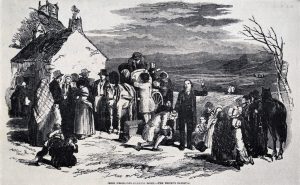
Farewell to Ireland.
1703, Queen Anne’s Test Act further discriminates against Scots-Irish Presbyterians (as well as Irish Catholics). Thus political and religious motives are added to economic woes that convince 200,000 Scots-Irish to emigrate to American colonies over the following decades, most as voluntary indentured servants.
1704, South Carolina establishes first slave patrols, administering passes, seeking fugitives and enforcing bans on slave gatherings for fear they could lead to insurrection. Patrols are gradually extended to other colonies, including Virginia (1726), North Carolina (1753) and Georgia (1757).
Patrols continue through end of Civil War, and provide framework for Ku Klux Klan and other vigilante operations during Reconstruction.
1704, Massachusetts “frontier” settlement suffers 47 English colonists killed by attacking French and Abenaki allies, who depart with 112 captives. Some of the latter die en route to Montreal; 60 are ransomed, and remaining are adopted by Mohawk families.
1706, French Louisiana colonists raid Chitimacha Indian settlements, kill many men and enslave many more, as well as women and children. Between war and disease, the tribe is practically wiped out by 1720.
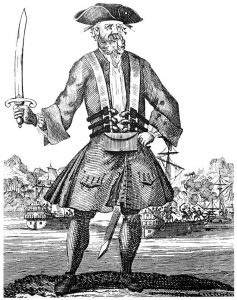
Blackbeard in command.
1706, “Republic of Pirates” rises in Nassau, Bahamas, after Spanish and French forces burn port and drive off British settlers. British privateers move in and harass Spanish and French through the 1714 close of Queen Anne’s War (aka War of Spanish Succession). Most then turn to piracy, with Blackbeard at one point selected as their magistrate. Nassau pirates finally defeated by ex-pirate Benjamin Hornigold, 1718.
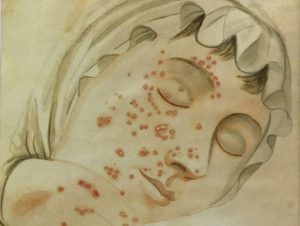
Sketch of a victim.
1706, In Boston, the slave Onesimus demonstrates an African method of fending off smallpox for his new master, Cotton Mather.
Vaccination: Take drops from a pustule of an infected patient, then cut the healthy recipient’s skin and insert the drops (it’s called variolation).
During a smallpox outbreak 15 years later, Mather convinces 280 persons in a generally distrustful Boston to accept the inoculation. Six die (2.2%) compared to 844 deaths (14.3%) among 5,889 non-inoculated patients.
Based on this success, and on similar experiences in London (where it was introduced from Turkey by the British ambassador’s wife), variolation is widely adopted throughout Britain and the American colonies.
Note: Edward Jenner performs his first smallpox vaccination—with cowpox—in 1796.
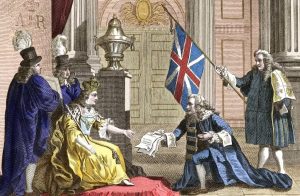 Now it's Great Britain.
Now it's Great Britain.
1707, With Acts of Union, English and Scottish parliaments combine into a single Parliament of Great Britain, May 1, building a much more unified British economy and a somewhat more unified population.
1708, Royal African Company, insolvent, transfers assets to African Company of Merchants, which continues Britain’s African operations through 1821.
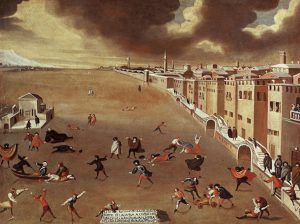 Venice's lagoon freezes.
Venice's lagoon freezes.
1709, Beginning in January, temperatures plunge across Europe, freezing the Thames (for two months), the Rhine and Po, and even Venice’s lagoon. It is the continent’s coldest winter since at least 1500 to the present.
Thousands freeze, and many more die from famine, which runs through 1710. It leads to food riots and to first large migration of Palatine Germans, who are also beset by marauding armies of France’s Louis XIV. 13,000 go first to England and Ireland (at invitation of Queen Anne), and then to New York’s Hudson and Mohawk valleys, Carolina and, later, in larger numbers, to Pennsylvania.
1709, Portuguese governor of Santiago, largest of the Cape Verde Islands, sends troops to subjugate maroon community of Julangue, estimated at 600. Success is not immediate; the maroons are still fighting in 1719.
1710, French introduce African slaves to Louisiana, most taken from Dutch and British slave ships during Queen Anne’s War. First slaves transported directly from Africa arrive in 1719, at Dauphin Island and Biloxi.
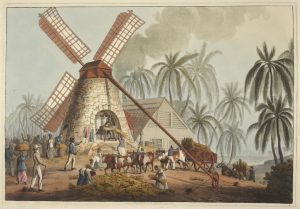 1710, Brazil’s Mascate (Sugar) War boils between Olinda, capital of Pernambuco and home of plantation and mill owners, and upstart Recife, where merchants and bankers gain upper hand as price of sugar drops.
1710, Brazil’s Mascate (Sugar) War boils between Olinda, capital of Pernambuco and home of plantation and mill owners, and upstart Recife, where merchants and bankers gain upper hand as price of sugar drops.
1711, In New York, a formal slave market opens at the East River foot of Wall Street. Operates through 1762.
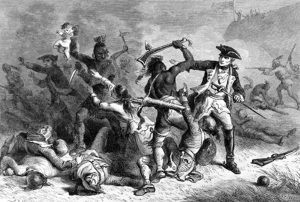 Settlers overwhelmed.
Settlers overwhelmed.
1711, Tuscarora War begins in North Carolina (then Albemarle province) with an Indian alliance killing hundreds of settlers and leaders in Bath and New Bern. South Carolina (then Clarendon province) sends white officers and 300 allied Yamasee and other Indians to force Tuscarora truce.
Fighting reignites the following year amid a yellow-fever outbreak that hits whites hard. Another Carolina contingent with many Indians (including Cherokee) uses artillery and explosives to reduce the Tuscarora’s Fort Neoheroka.
Many Tuscarora begin migration to mid-New York where they will be accepted as sixth Iroquois nation.
1712, Uprising in New York City, in which 23 black slaves set fire to building on Maiden Lane, near Broadway, and kill nine whites, April 6. Seventy blacks are arrested. Six commit suicide, 27 tried, 20 burned to death and one executed on breaking wheel. Repressive laws follow, including requirement that masters who free slaves post a large bond, and decreased contact among slaves. Slave population is estimated at 1,000 of 7,000 total.
1712, South and North Carolina created from the two provinces, Clarendon and Albemarle, respectively, of the original Carolina colony.
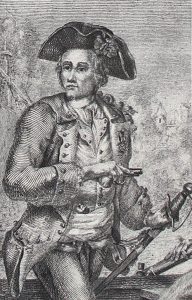 Jacques Cassard.
Jacques Cassard.
1712, Jacques Cassard, with eight French warships, loots and destroys Ribeira Grande on Cape Verde island of Santiago. This squadron crosses Atlantic, meets with pirates from Saint-Domingue. Together they sack Montserrat and Antigua (both British) and then bombard Meerzorg, extorting a ransom from Surinam and making possible the escape of hundreds of plantation slaves into the forest.
Cassard finishes up with Berbice and Essequibo (Dutch Guyana), Sint Eustatius and heavily fortified Curaçao. Returns to Toulon with one of the grandest single-voyage hauls ever of treasure, goods and slaves.
This all takes place as Treaty of Utrecht is being negotiated.
1713, Treaty of Utrecht ends War of Spanish Succession. Britain, Portugal and Netherlands accept Philip IV as Bourbon king of Spain, but he must drop any claim to French throne. Britain wins Gibraltar (which it holds to this day) and recognition of its possession of Jamaica since 1655.
British merchants (South Sea Company) gain Spanish asiento to deliver 4,800 slaves annually to Spain’s colonies in America. British hold the asiento until 1750. South Sea hires African Company of Merchants, which mounts 96 voyages over 25 years, purchasing and shipping 34,000 enslaved blacks, 30,000 of whom survive to reach reception factories at Cartagena, Vera Cruz, Portobelo and Havana, and Jamaica as well.
1713, Escaped slaves, many able to flee during 1712 French raid, create Ndjuka (maroon) communities in Surinam jungle under Alabi, Boni and Capt. Broos. Dutch colony reports 200 plantations and 13,000 slaves, the great majority African.
1715, Yamasee and allied tribes, including Catawba and Cherokee, rise up in South Carolina to end settler slave raids. Port Royal attacked, smaller settlements destroyed and more than 100 settlers and slaves killed. Ninety white traders also die in individual confrontations. South Carolina desperately gives land to remaining Tuscarora to win their help against Yamasee. Cherokee switch to join settlers.
Tuscarora and Yamasee wars sharply reduce potential Indian slaves through new reliance on Indians as allies, as well as through death and migration. Carolina planters import increasing numbers of African slaves by 1717.
1715, Hurricane overtakes 12-ship Spanish treasure fleet, outbound from Havana, as it emerges from Bahamas Channel. The lead ship, a French frigate with no treasure, escapes, but three galleons sink in deep water and the rest are driven onto Florida beaches (just north of present-day Vero Beach). More than 1,000 sailors die, including commanding Adm. Don Juan de Ubilla.
Most of the treasure, perhaps 7 million silver pieces of eight, is recovered by 300 divers, African and Indian slaves.
1716, Whydah booms on the Slave Coast (present-day Benin) with King Haffon loading 500 captives and much gold aboard the British Whydah Gally (commissioned by London banker and slave-merchant Humphry Morice).
After trading slaves in Caribbean for sugar, indigo and rum, Whydah Gally is captured off the Bahamas by pirate “Black Sam” Bellamy who then heads up the East Coast. Ship is storm-wrecked off Cape Cod, April 26, 1717; Bellamy and all but two of the crew die.
In 1984, wreckage and treasure (15,000 African gold coins and 60 cannon, plus loot from other ships taken by pirates) is discovered by archaeologist Barry Clifford and identified by a ship’s bell inscribed with her name.
1718, New Orleans (La Nouvelle-Orléans) founded by Jean Baptiste le Moyne de Bienville. Earlier, De Bienville founded Old Biloxi and La Mobile (at the mouth of Mobile Bay).
The first enslaved Africans in Louisiana are purchased at Whydah and carried by the Duc du Maine, with 250 landed at Biloxi, 1719.
Louisiana is to generate revenue for the Mississippi Company and various financial offshoots directed by John Law, a Scotsman serving as France’s controller general. Demand for Mississippi Company stock leads to sudden inflation, and a run on banks for gold and silver as the “Mississippi Bubble” bursts, 1720.
Two years later, a hurricane blows most of little New Orleans’ flimsy structures away.
1719, Defoe’s novel, published in London April 25, is a huge best seller. The protagonist trades for gold in Guinea, is enslaved by Salé pirates, escapes with a younger slave whom he later sells, starts a sugar plantation in Brazil and is shipwrecked off Venezuela on his way to trade for slaves in Africa. He is marooned on an island for 28 years.
His man Friday? An Indian whom Crusoe saves from native cannibals.
Defoe is believed to have based his story, in part, on the 1705 marooning of privateer Alexander Selkirk on a Pacific island. Selkirk, rescued after four years, dies of yellow fever aboard a Royal Navy ship on an anti-pirate patrol off West Africa, Dec. 13, 1721.
1720s, Joseph Wragg and Benjamin Savage establish themselves as slave traders in Charles Town for all 13 colonies. Their fleet of 36 slave ships imports 10,000 enslaved people between 1717 and 1744, dealing first with the Royal African Company and its factory in Gambia.
They go independent in the 1730s, obtaining human cargos from the Portuguese in Luanda. Between 1735 and 1739, Joseph Wragg & Company receives 20 cargoes of African slaves. Charleston’s Wraggborough section is named for the family.
1722, Short but spectacular buccaneer career of Bartholomew Roberts ends with his death in a broadside from HMS Swallow off Cape Lopez (present-day Gabon), Feb. 10, 1722.
Last great pirate: A mate on a slaver, Roberts and his ship were captured by pirate Howell Davis at Anomabo (near Cape Coast Castle) in June 1719. Roberts then agreed to join the pirates. (Davis himself had been a mate on another slaver when he turned pirate a year earlier.)
When Davis died in an attack on the Portuguese island of Príncipe his men elected Roberts as their new captain. He led them back to Príncipe for bloody and profitable revenge. The crew then opted to cross Atlantic to Brazil where they discovered a fleet of 42 Portuguese merchant ships in All Saints’ Bay (Salvador).
Looting the richest ship (carrying gold and jewelry for King João V), they then sailed north to Newfoundland, sweeping up Grand Banks fishing ships. At Trepassy, they captured 22 merchant ships and another 150 fishing vessels.
Returning to the Caribbean in the fall of 1720, they took more ships off St. Kitts and St. Lucia, and all but shut down navigation in the West Indies. Roberts returned to West Africa in April and captured two French ships near the Senegal river. In Whydah harbor, Roberts allowed captains of 11 slave ships to ransom them for eight pounds of gold dust each. One was set afire when the captain declined; as many as 80 trapped Africans died.
After killing Roberts and two other pirates on the Royal Fortune, Swallow rounds up 272 men, including 65 Africans who had been freed by Roberts; they are returned to slavery. Of the remaining crews, many die on the voyage to Cape Coast Castle where 52 are hanged. Another 17 are sent to Marshalsea Prison in London.
In less than three years, Roberts and his men captured more than 400 ships. It was the high point of Atlantic piracy.
1722, Major earthquake (perhaps 7.8R) strikes Portugal’s Algarve, followed by a tsunami, Dec. 27, damaging buildings in Tavira, Albufeira, Faro and Loulé.
